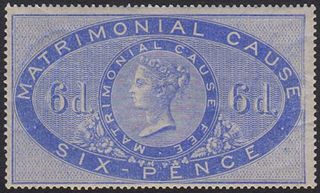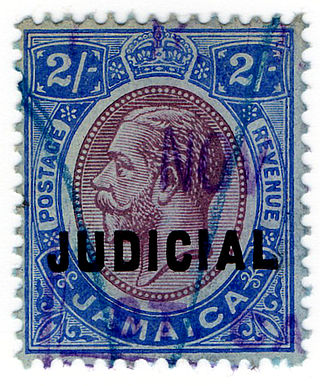
In philately, private overprints or commercial overprints are overprints applied to postage stamps, postal stationery or revenue stamps by anyone other than the official stamp-issuing entity. These overprints have principally been used as a security measure, however, propaganda and commemorative examples are also known. When overprinted for security purposes, they serve a similar function to perfins. It is important to distinguish between private overprints and private cancellations.

The British Central Africa Protectorate existed in the area of present-day Malawi between 1891 and 1907.

A revenue stamp, tax stamp, duty stamp or fiscal stamp is a (usually) adhesive label used to designate collected taxes or fees on documents, tobacco, alcoholic drinks, drugs and medicines, playing cards, hunting licenses, firearm registration, and many other things. Typically, businesses purchase the stamps from the government, and attach them to taxed items as part of putting the items on sale, or in the case of documents, as part of filling out the form.

In philately, indicia are markings on a mail piece showing that postage has been prepaid by the sender. Indicia is the plural of the Latin word indicium, meaning distinguishing marks, signs or identifying marks. The term imprinted stamp is used more or less interchangeably, but some indicia are not imprinted stamps. One example is the handstamp, which can be seen in a photo on this page.

The postage stamps of Ireland are issued by the postal operator of the independent Irish state. Ireland was part of the United Kingdom of Great Britain and Ireland when the world's first postage stamps were issued in 1840. These stamps, and all subsequent British issues, were used in Ireland until the new Irish Government assumed power in 1922. Beginning on 17 February 1922, existing British stamps were overprinted with Irish text to provide some definitives until separate Irish issues became available. Following the overprints, a regular series of definitive stamps was produced by the new Department of Posts and Telegraphs, using domestic designs. These definitives were issued on 6 December 1922; the first was a 2d stamp, depicting a map of Ireland. Since then new images, and additional values as needed, have produced nine definitive series of different designs.

A specimen stamp is a postage stamp or postal stationery indicium sent to postmasters and postal administrations so that they are able to identify valid stamps and to avoid forgeries. The usual method of invalidating the stamps is either overprinting in ink or perforating the word Specimen across the stamp and where English is not the common language, the words Muestra (Spanish), Monster (Dutch), Muster (German) or Образец have been used instead.

In philately, an imprinted stamp is a stamp printed onto a piece of postal stationery such as a stamped envelope, postal card, letter sheet, letter card, aerogram or wrapper. The printing may be flat upon the surface of the paper, or embossed with a raised relief. An imprinted stamp is also known as unadhesive stamp or indicium.

In philately the word imprimatur refers to the first stamps printed from an approved and finished printing plate.

Burelage, also burelé, is a French term referring to an intricate network of fine lines, dots or other designs printed over or as the background of some postage or revenue stamps to prevent counterfeiting. In English the word is sometimes spelled with an accent on the first "e" as burélage, although the accent does not appear in the French spelling and its origin is unclear. Burelage most commonly appears as a form of underprinting.

Key type stamps are stamps of a uniform design that were widely used by colonial territories in the 19th and 20th centuries.

Panama was formerly a department of Colombia and used overprints of Colombian stamps from 1878 until it gained independence in 1903. However, from 1903 to 1905 sets of stamps with overprints were still used and it was only in 1906 that the first printed stamps by the Panamanian postal administration were produced with República de Panamá.

India has been a heavy user of revenue stamps, both before and after independence. The first revenues were issued in the mid-nineteenth century and they are still being issued to this day. Apart from issues for the whole of India, many princely states, provinces and other states also had or still have their own revenue stamp issues.

Revenue stamps of Malta were first issued in 1899, when the islands were a British colony. From that year to 1912, all revenue issues were postage stamps overprinted accordingly, that was either done locally or by De La Rue in London. Postage stamps also became valid for fiscal use in 1913, so no new revenues were issued until 1926–1930, when a series of key type stamps depicting King George V were issued. These exist unappropriated for use as general-duty revenues, or with additional inscriptions indicating a specific use; Applications, Contracts, Registers or Stocks & Shares. The only other revenues after this series were £1 stamps depicting George VI and Elizabeth II. Postage stamps remained valid for fiscal use until at least the 1980s.

Revenue stamps of the United Kingdom refer to the various revenue or fiscal stamps, whether adhesive, directly embossed or otherwise, which were issued by and used in the Kingdom of England, the Kingdom of Great Britain, the United Kingdom of Great Britain and Ireland and the United Kingdom of Great Britain and Northern Ireland, from the late 17th century to the present day.

Trinidad and Tobago, formerly divided as two separate colonies, issued revenue stamps from 1879 to around 1991.

A postal fiscal is a revenue stamp that has been authorised for postal use. Postal fiscals may arise because there is a shortage of postage stamps for a country or out of economy to use up obsolete or excess stocks of revenue stamps. Postal fiscals are to be distinguished from stamps marked "Postage and Revenue" which were always intended for either use, or revenue stamps used postally by accident or because local postal regulations did not prohibit such use. Postal fiscal status may usually only be identified from the cancels on used stamps or where the stamp is found on cover.

The South African Republic (ZAR), later known as Transvaal issued revenue stamps from 1875 to around 1950. There were a number of different stamps for several taxes.

New Zealand first issued revenue stamps on 1 January 1867 and their general use continued until the early 1950s. The only Revenue Stamp series still in use today is the Game Bird Habitat stamp which is used for payment of the Gun License for the duck shooting season which begins the first weekend of May. There were various types of fiscal stamps for different taxes.

Revenue stamps of Jamaica were first issued in 1855. There were various types of fiscal stamps for different taxes.
John Barefoot is a British philatelist, stamp dealer, and publisher, best known for his catalogues of revenue stamps which are known collectively as the "Barefoot catalogue".





















